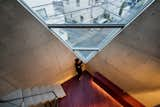A Concrete Micro House in Japan Works All the Angles
When Tokyo-based architecture firm Atelier Tekuto received a brief from their clients to build a distinctive, environmentally-conscious concrete home, they embarked on a two-and-a-half year journey of spacial and material exploration. Built in 2015, the result—the R Torso C project—won the Overall Excellence Award and first place in the low-rise buildings category at the 2017 American Concrete Institute Awards.
Working on a small, corner plot of roughly 718 square feet in a densely populated neighborhood of Tokyo, Atelier Tekuto increased the home’s floor plan by building skywards. A living room, dining room, kitchen, and bathroom make up the top floor, while the first floor features a spacious gallery and a traditional "Japanese room," which has a tatami mat floor. The basement houses an insulated audio visual room.
According to the firm, sectional and volumetric design is a cornerstone of building micro houses such as the R Torso C project. "Since small houses on small sites have limited floor area, cross-sectional, vertical elements such as ceiling heights, the connection between floors, the placement of voids are essential to create comfortable interior space," says Yasuhiro Yamashita of Atelier Tekuto.
The studio, which is known for its micro houses, also relies on strategic placement of windows and skylights to maximize the perception of space. Yamashita adds that the use of similar colors and textures also makes the space seem larger than it actually is.
To meet their clients' request for eco-friendly building materials, Atelier Tekuto developed a formula for recyclable concrete as an alternative to sand-based concrete. The key ingredient in the concrete is shirasu, an extremely fine volcanic ash that comes from the south of Japan. Shirasu offers more durability and density that traditional concrete, and its smooth texture creates an ideal finish for exposed concrete surfaces. The new concrete is still under development, but has potential applications for environmentally-friendly architecture.
Structural Engineer: Jun Sato Structural Engineers
Shirasu Product Manufacturer: Principle Co.
Concrete Producer: Tokyo SOC Inc.
Cooperative University: Professor Takafumi Noguchi, Tokyo University
Published
Last Updated
Get the Dwell Newsletter
Be the first to see our latest home tours, design news, and more.














